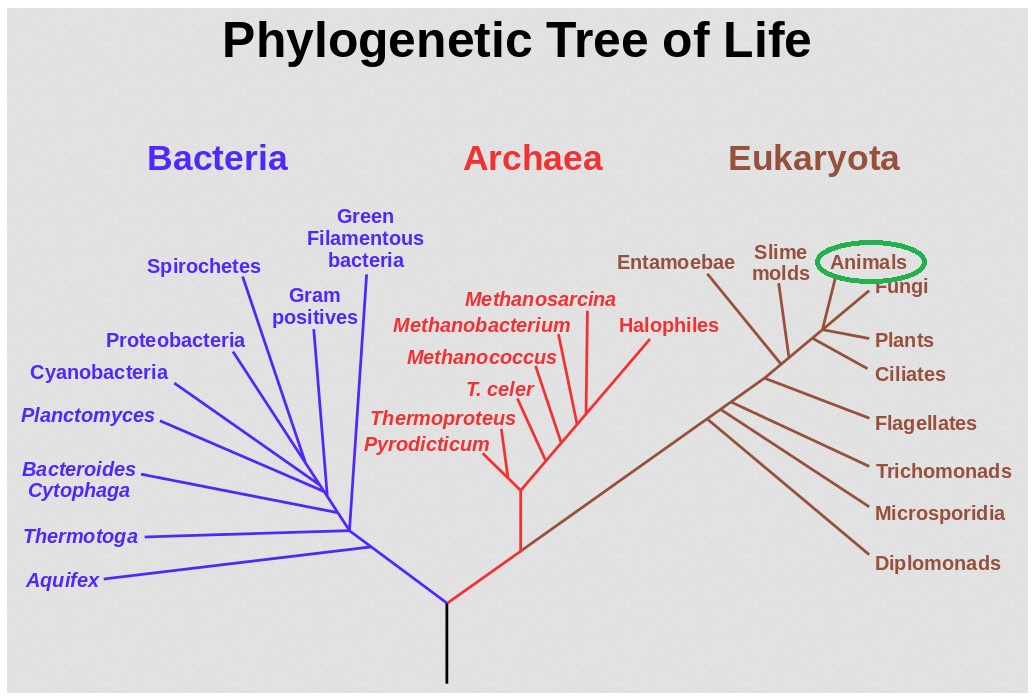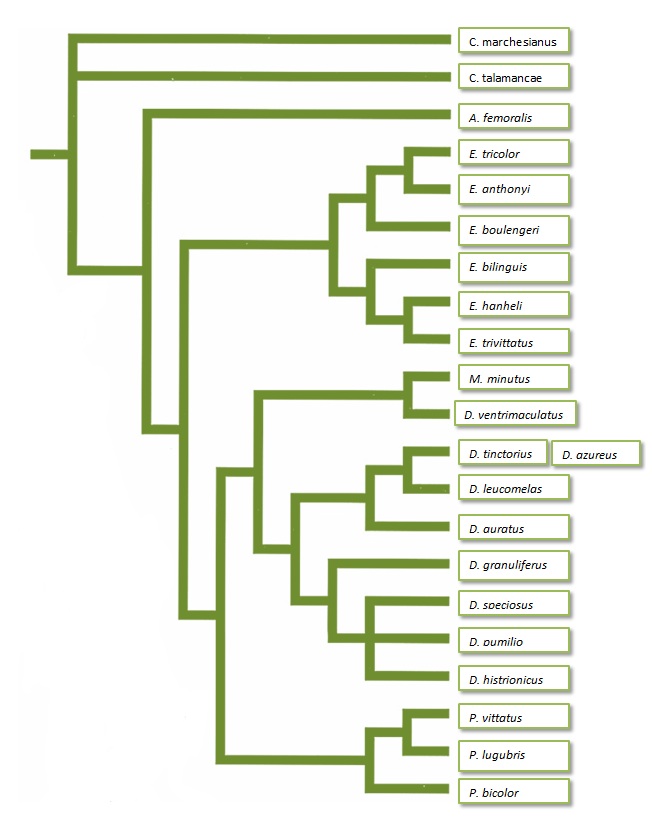Classification
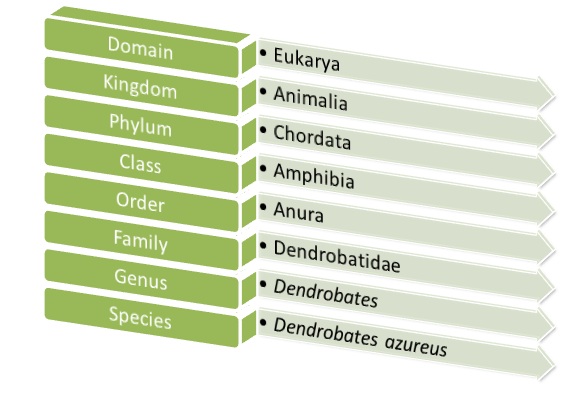
Domain (Eukarya): The
Domain Eukarya is filled with organisms which, as
the name implies, have eukaryotic cells. These
cells have membrane-enclosed organelles, divide by
mitosis, and can be unicellular, colonial, or
multicellular. You can see below where the
Domain Eukarya and the Kingdom Animalia fall in to
the phylogenetic tree of life, the kingdom the
Dyeing dart frog falls into being circled.

Kingdom (Animalia): The
Kingdom Animalia contains multicellular and
heterotrophic organisms. That is to say that Animalia based organisms have more a "more than one
cell" makeup and that they obtain nutrition by
breaking down existing organic compound, unlike
plants which photosynthesize to create sucrose for
energy. One organism from this kingdom which
you may have seen outside near a lake or pond is a
swan, which is multicellular.
Phylum (Chordata): The Phylum
Chordata is most likely the phylum most familiar to
many people because within it are humans and other
vertebrates, including of course Dendrobates
azureus. To be technical and precise,
there are five specific characteristics which all
chordates exhibit throughout at least one point in
their lifetime. These include: pharyngeal
slits, a dorsal nerve cord, a notochord, a post-anal
tail, and an endostyle. Pharyngeal slits are
sometimes presented as gills in particular organisms
but in animals which do not use gills these slits
are gaps or openings which lead from the interior of
the throat to the exterior of the area of the neck.
A dorsal nerve cord is a cluster of nerves and nerve
fibers which line the dorsal (or back) side. A
notochord is a structure made of cartilage which
follows underneath and supports the nerve cord.
A post-anal tail is seen in many embryonic forms of
the chordates and is a small protrusion of the body
located above the anus of an organism.
Class (Amphibia): The Class
Amphibia has organisms which lead a life involving
both water environments and land environments.
These organisms have anamniotic eggs which mean that
in place of shells the eggs are laid with multiple
gelatinous layers for protection. They also
cannot regulate their body temperature and due to
the makeup of their skin they must usually remain
within moist to wet and warm climates. While
you may say, "Oh yea, of course frogs are in the
Class Amphibia. They're amphibians!" this
doesn't mean that the only animals in the Class
Amphibia are frogs. The
Spotted Salamander is another organism in this
class, differing from the Dyeing dart frog only in
the taxonomic classification concerning Order.
Order (Anura): The Order
Anura names amphibians which are characterized as
having no tails in adulthood (which is unlike the
salamander, linked above, which is in the Order
Caudata), as being unequal quadrupeds (four limbs,
the hind legs usually being longer than the fore
limbs), and as having external fertilization.
They also have more pronounced pelvic joints to
allow for an enhanced jumping ability. Another
organism which shares this Order is the
Red Eyed Tree Frog, which truly exemplifies the
jumping abilities of this classification level.
Family (Dendrobatidae): This
Family Dendrobatidae describes anurans which are
small, exhibit bright color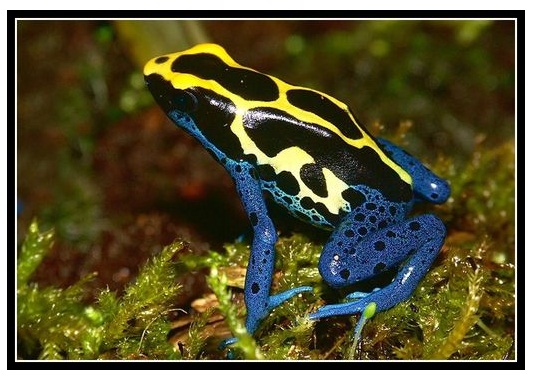 patterns, and are neotropical (referring to a specific region of the
world). They are not however limited to frogs
whose scientific names mimic this Family.
Phyllobates terribilis is another poison
dart frog which differs from the Dyeing dart frog
taxonomically at the next level. There are now eleven genera which
further divide this taxonomic group, having recently
been revised. The more derived poison dart
frogs are known for their production of skin
alkaloids which are excreted through the skin and
sourced from the insects in the diet of those
specific genera.
patterns, and are neotropical (referring to a specific region of the
world). They are not however limited to frogs
whose scientific names mimic this Family.
Phyllobates terribilis is another poison
dart frog which differs from the Dyeing dart frog
taxonomically at the next level. There are now eleven genera which
further divide this taxonomic group, having recently
been revised. The more derived poison dart
frogs are known for their production of skin
alkaloids which are excreted through the skin and
sourced from the insects in the diet of those
specific genera.
Genus (Dendrobates): The
Genus Dendrobates, as its name implies, further
specifies the members of the family Dendrobatidae
which are found in high humidity and temperature
habitats. Most of these frogs are terrestrial,
living among dead leaves and other such ground
litter which covers the forest floor. Only a
few are arboreal, having the ability and common
behavior of climbing trees. They are not
particular to inhabiting pools of water, and very
rarely will go for a dip unless it is to lay eggs.
Species (Dendrobates
azureus): These
Dendrobates are most notably distinct in skin
coloration and finger formation. The
fingertips lead into discs with the first finger
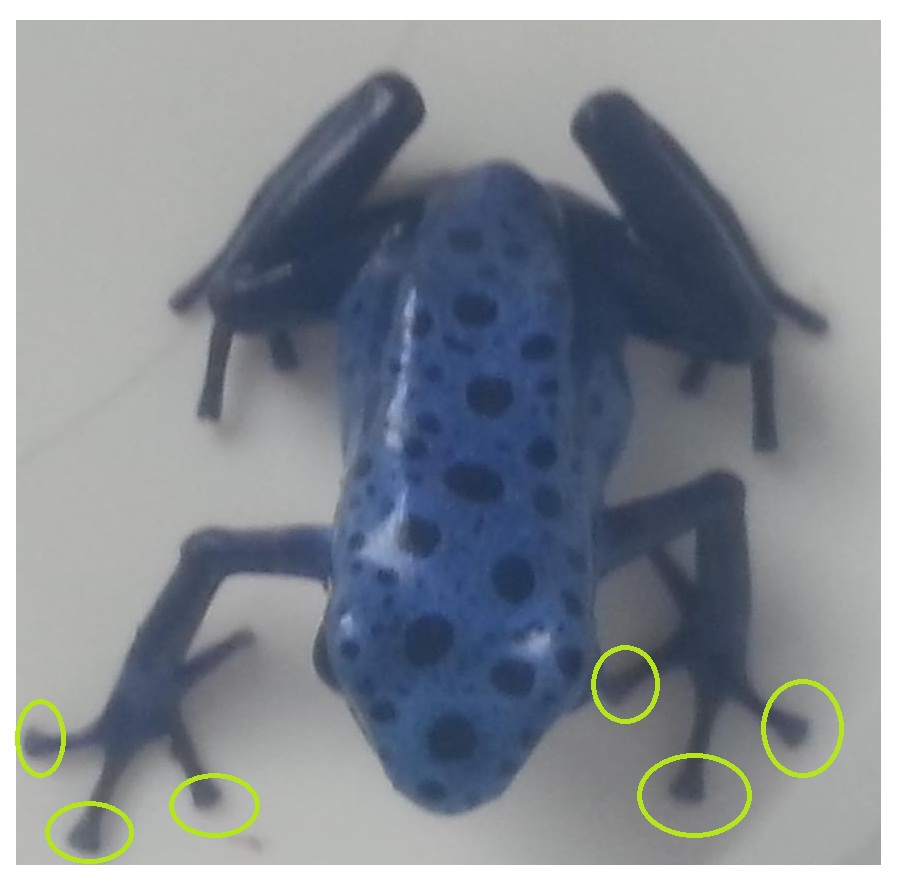 being the smallest, the second the largest, and the
third and fourth of equal length to each other
though intermediate in respect to the first two
fingers. You can see examples of these finger
discs in the image of Perdita to the right. There is no hint of webbing between
any of the fingers. The toes lead into more
triangular shaped discs, being smaller than the
fingers although also lacking webbing. They
are described as being bright blue, sometimes a
sky-blue, with black spots all over the body.
There is a darker blue, almost purple shade tinting
all four limbs, portions of the underbelly, and the
lower part of the back (which turns the obvious
spots located there to barely discriminate from the
darker colouration). There is no regular
pattern to the frogs'
being the smallest, the second the largest, and the
third and fourth of equal length to each other
though intermediate in respect to the first two
fingers. You can see examples of these finger
discs in the image of Perdita to the right. There is no hint of webbing between
any of the fingers. The toes lead into more
triangular shaped discs, being smaller than the
fingers although also lacking webbing. They
are described as being bright blue, sometimes a
sky-blue, with black spots all over the body.
There is a darker blue, almost purple shade tinting
all four limbs, portions of the underbelly, and the
lower part of the back (which turns the obvious
spots located there to barely discriminate from the
darker colouration). There is no regular
pattern to the frogs'
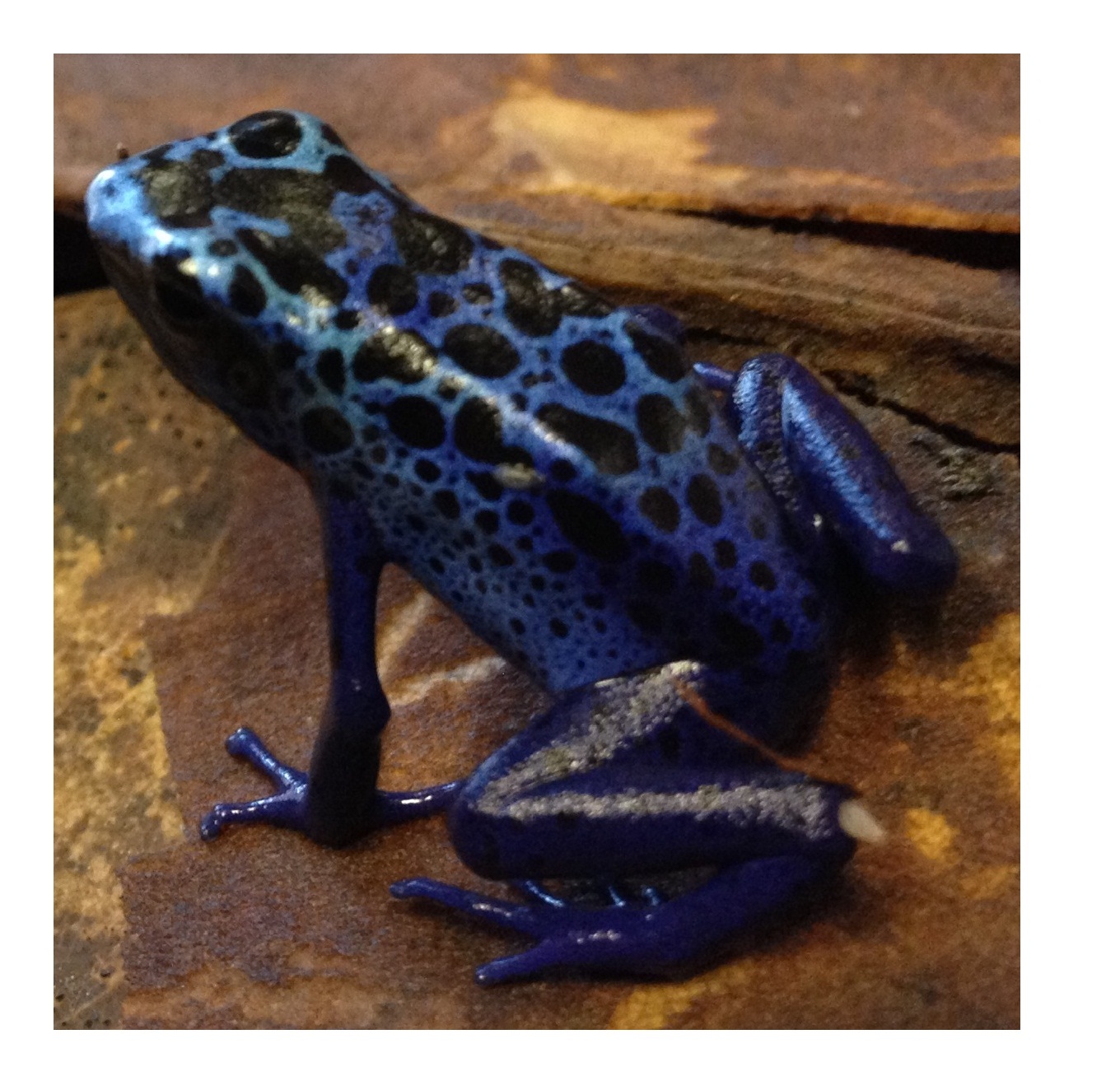 spots, though the spots themselves are round and exhibit different sizes.
The belly tends to have smaller sized spots while
the back has larger, more discernible spots.
Spot patterns are wide and varied between
individuals, some having next to no spots on the
throat and belly while others can have almost
completely blackened areas. (Obersve the
differences between the spotting pattern of Perdita
to the right and Pongo to the left.) The eyes of these
frogs has been described as dark red-brown.
Compared to its relatives, this frog has a more
pronounced hunched back which also leads to a slight
bulge like belly.
spots, though the spots themselves are round and exhibit different sizes.
The belly tends to have smaller sized spots while
the back has larger, more discernible spots.
Spot patterns are wide and varied between
individuals, some having next to no spots on the
throat and belly while others can have almost
completely blackened areas. (Obersve the
differences between the spotting pattern of Perdita
to the right and Pongo to the left.) The eyes of these
frogs has been described as dark red-brown.
Compared to its relatives, this frog has a more
pronounced hunched back which also leads to a slight
bulge like belly.
Below I've included a phylogenetic tree based off of mitochondrial DNA sequencing, which shows the relationships of other species of frogs compared to Dendrobates azureus. The reason Dendrobates azureus is shown right next to D. tinctorius is because it is most likely a sub-species of D. tinctorius due to the difference in colouring patterns.
